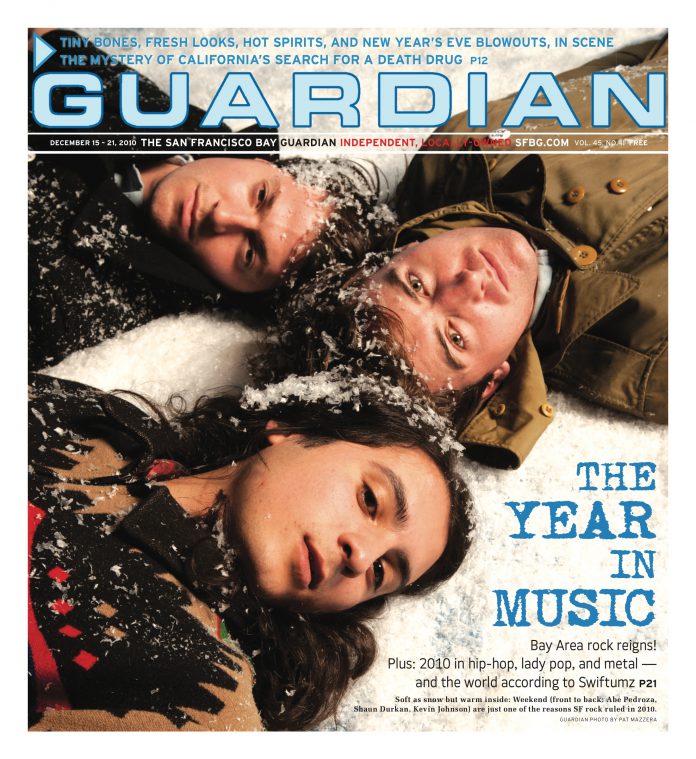arts@sfbg.com
YEAR IN MUSIC Sometimes it appears that metal is aging backward in time, like a jean-jacketed, beer-swilling Benjamin Button. A cannibalistic hunger for old tropes sends budding musicians traveling deeper and deeper into the past for inspiration. By the beginning of 2010, the corpse of thrash metal was well and truly picked over, and as a legion of teenage “retro-thrashers” began to wear holes in their all-white high-tops, a new reverence emerged, one that looked beyond the aggression and speed of the middle 1980s, hearkening back to an earlier, heavier time.
This appetite for headbanging history was nurtured by 2010’s profusion of reunion tours. Emboldened by the music’s broadening audience, aging musicians the world over have been emerging from seclusion (voluntary or otherwise) and honing in on ticket territory that recently belonged to their younger colleagues.
Traditional doom metal was robustly resurrected; cult late-1970s acts St. Vitus and Pentagram both graced the stage at DNA Lounge, with mixed results. Considering the promise evinced by its summer 2009 appearance at the same venue, Pentagram was disappointing, though a last-minute lineup change was made the scapegoat. St. Vitus was another matter, thundering forth on the strength of guitarist Dave Chandler’s dive-bombing psychedelia and singer Scott “Wino” Weinrich’s booming baritone. The renewed vigor of the legendary L.A. outfit made the recent death of original drummer Armando Acosta especially poignant, though he had not played with the band for some time.
Metal was robbed of another sainted figure this year: Ronnie James Dio, whose inimitable voice and boundless energy made him one of the best-liked musicians in the business. His performances remained impeccable almost to the bitter end, which exacerbates the sense of loss. Fans can take comfort in the fact that he died during 2010, a year that witnessed a veritable renaissance of exactly the kind of late-1970s metal Dio did so much to popularize.
The fervor for classic, “traditional” metal was on display this past summer at Tidal Wave, a free concert in McClaren Park that featured three reinvigorated acts as its second-day capstone, each interpreting genre-progenitors Iron Maiden and Judas Priest in its own particular way. Anvil Chorus was formed during the dawn of the Reagan administration, and “Blondes in Black” and “Deadly Weapons” served as catchy centerpieces to an expertly-played set. Bay Area treasures Stone Vengeance, an all-African American trio from Hunter’s Point, showed why it has been able to survive for more than three-decades, combining engaging enthusiasm, unimpeachable technique, and a deep-seated sense of humor. U.K. legend Raven was the headliner, belying its advanced years thanks to rapid tempos, vertiginous falsetto, and captivating NWOBHM licks.
Elsewhere, German legend Accept released a new album and set out on the road, and long-running S.F. veterans Slough Feg returned this year with The Animal Spirits, a potent full-length. And yet a love of melody, guitar harmony, sung vocals, and galloping drums is no longer limited to hoary veterans. This year also witnessed a crop of new bands that drew heavily on late-1970s and early-1980s inspiration to craft a compelling crop of fiery LPs.
Sweden’s Enforcer (Diamonds) and Steelwing (Lord of the Wasteland) and L.A.’s Holy Grail (Crisis in Utopia) all took advantage of their klaxon-throated singers to release albums that draw heavily on classic Judas Priest, with a particular focus on high-register vocal melody and a bevy of shredding. Breakout Olympia, Wash., group Christian Mistress took a slightly different approach. The group’s EP Agony & Opium leavens influential British outfit Diamond Head with the unique, melancholy delivery of singer Christine Davis.
If metal spends 2011 in this same archaeological mind-set, the Blue Cheer comparisons will start to fly fast and thick. But while some may decry the stultification that accompanies veneration of the retro, they cannot deny its curatorial power. Like Dio himself, the metal of the past is destined to live again, in the overburdened eardrums of the present.

